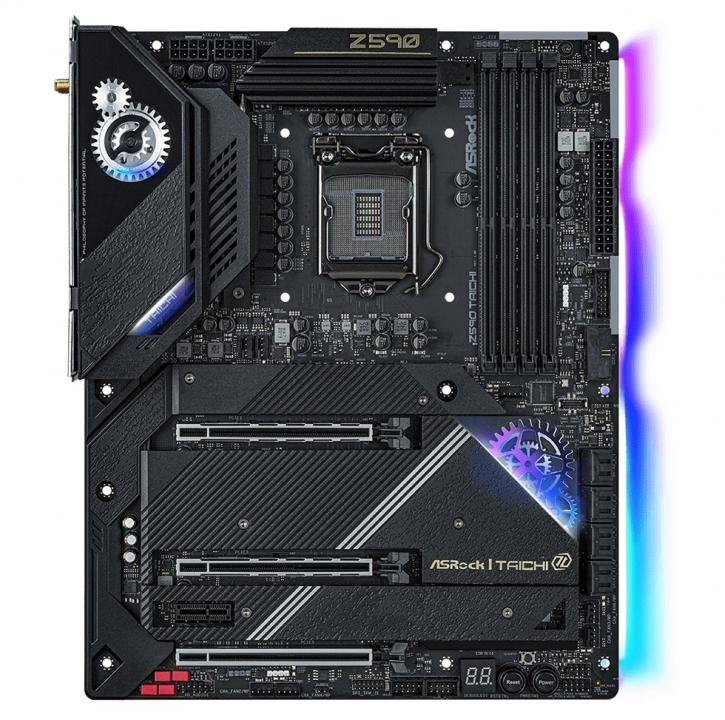Final Words & Conclusion
Conclusion
The Asrock Z590 Taichi certainly is an exciting product. It looks well. There are two addressable and two regular LED strip headers for RGB lovers and one CPU cooler LED strip header, with excellent access to eight 4-pin headers overall. The DDR4 slots support up to 128 GB of RAM and handle up to DDR4-5000 memory (with 11th gen processors; with 10th gen, it’s 4800 MHz) result. The Asrock Z590 Taichi has only a single primary PCIe 4.0 x16 slot supported by the processor, and the chipset provides an extra PCIe 3.0 x4 slot. The audio for this board does look nice, with the Realtek ALC1220 codec paired Nahimic. The M.2 slots support one PCIe 4.0 x4 drive and two PCIe 3.0 x4 drives. The price of the Asrock Z590 Taichi is about 460 USD, which makes it expensive. You might want to know that this board has robust, 12+2 power delivery.
DDR4 Memory
Memory compatibility should not, and likely will not be an issue as long as you stick to recently released DIMMs. There are many excellent Intel-optimized kits out there (more than for the Ryzen CPUs). Also - go for at least 16 GB in dual channel, with a frequency of 3200 MHz (CL14/CL16) or 3600 MHz (CL16/CL18).
Power consumption
The Intel Core i9 10850K doesn’t shine in the power consumption department. It’s a 125 Watt TDP processor. With the system at idle with a GeForce RTX 2080 Ti installed / 32 GB memory / SSD and the Z590 motherboard, I hovered at roughly 70 Watts in IDLE. The Z590 doesn’t benefit it (and why would it?), so when we stressed the processor, we reached 200-250 Watts of power consumption. We used a 10-core CPU with this Z590 board, which is the max number of cores available.
Performance & tweaking
The ten cores like a bit of extra voltage if you’re looking to do some tweaking. To get to 5.1~5.2 GHz on all cores, you will probably need at least 1.35, or instead closer to 1.4-1.45 V on the processor. This makes power consumption grow rather rapidly. If you plan a tweak at that 5.2 GHz mark, then you will need LCS. The process of OC that Z590 offers is easy to use: you increase the CPU voltage and multiplier, and that’s it. Another plus for the Intel platform is that they have refined their memory controllers over the years. Pop in anything XMP 2.0, and you have more than a 90% chance it’ll work straight out of the box with high-speed memory. The temperatures of VRMs are good, even with an overclocked CPU.
Final words
The ASRock Z590 Taichi is the best model from Asrock’s Z590 family. With an integrated I/O shield, solid RGB implementation, PCIe 4.0 compatibility with future CPU generations (both for the GPU and the NVMe drives), the ASRock Z590 Taichi has all the things you need. It looks excellent – with this metal gear mechanism on the IO area. Also, it’s rigid (including the backside metal cover), has a great feature set, and performs well. The Z590 Taichi should handle even the 8-core Intel Core i9 11900K (14 phase VRM with 90A MOSFETs) without reaching high temperatures of the power delivery section. The price is about 460 USD, so a lot, but you get two ethernet ports (one of them is 2.5 Gbit), an 802.11ax Wi-Fi 6E Module, 14-phase power, very nice audio performance (although it would be suitable to see something fresher than ALC1220), as well as 3x NVMe ports and 8 SATA ports (but there are dependencies and you can’t use all of them – I mean NVMe and SATA at once). It’s good that there are two USB 3.2 Gen 1 connectors on the motherboard (for me, as a user of Phanteks 719, it’s a must). The buttons for power/reset/clear CMOS can also come in handy when overclocking. Additionally, you get Asrock’s GPU Holder solution, which should help prevent the graphics card from sagging. RGB lovers can enjoy two regular and two addressable RGB headers for the bling. In the bundle, there is also a graphics card holder that attaches directly to the motherboard. On the other side, there are some drawbacks. You get only six “regular” USB ports at the back panel, yeah – you get two Thunderbolt 4.0, but still. You can always install the USB 2.0 bracket, but this may not satisfy the customer. Also – the location of the CPU fan headers is… very strange. It’s harder to route the fan cables with that location than the usual top-right corner of the motherboard. What was the idea here? As mentioned earlier – “only” ALC1220 is provided here (competition can offer more, like ALC4082), but luckily there’s a DAC for the front panel output. Last but not least, the post time is rather long, it’s over 20 seconds, and competition can do it faster. The Asrock Z590 Taichi deserves the Recommended award for all that it delivers, but you need to remember the 460 USD price tag, and the competition is robust. In the end, ASRock’s Taichi is a solid upper-mid-range/high-end option for your 10th (or better 11th) generation Intel system.
Handy related downloads:
- Sign up to receive a notification when we publish a new article
- Or go back to Guru3D's front page



